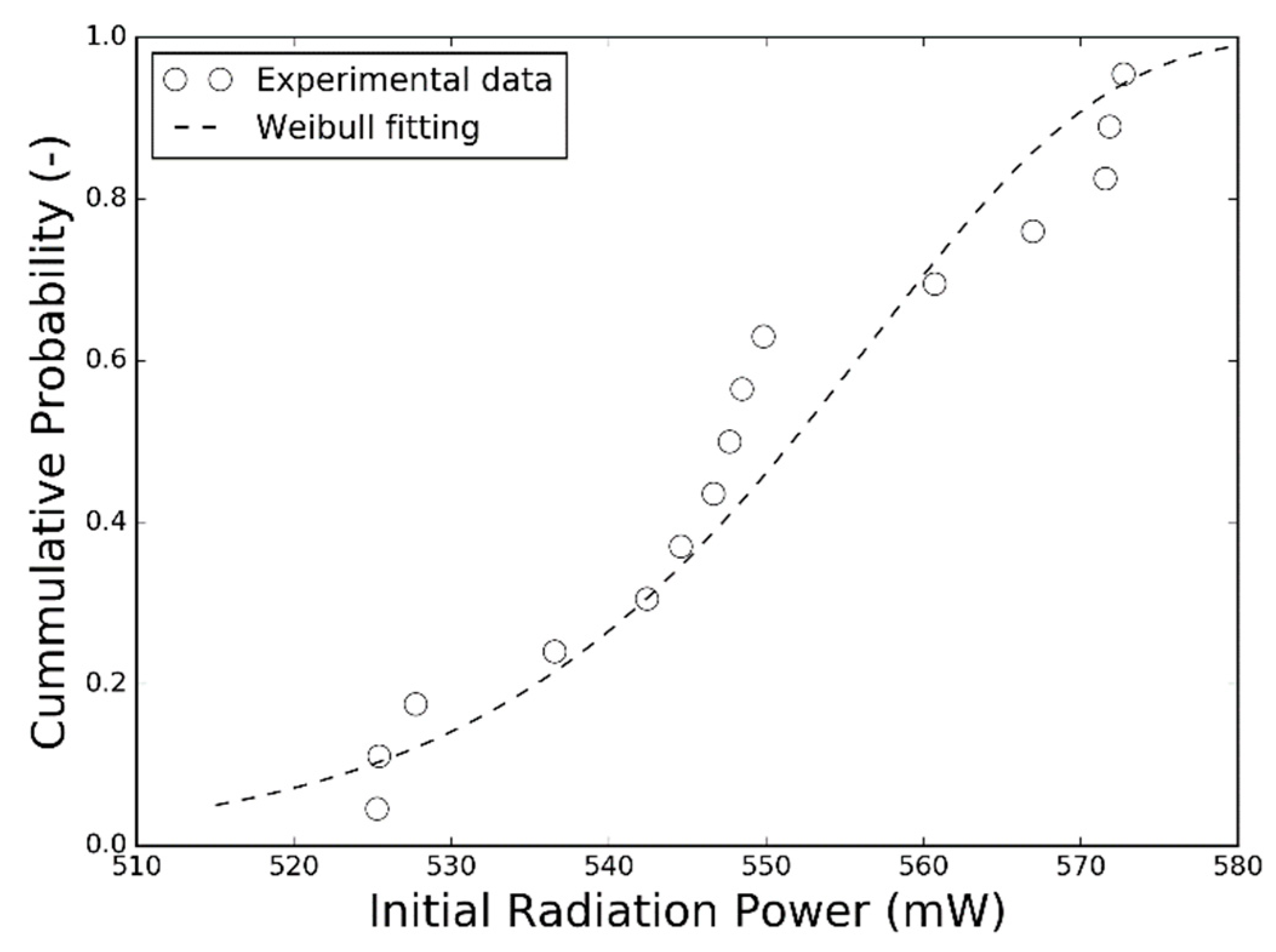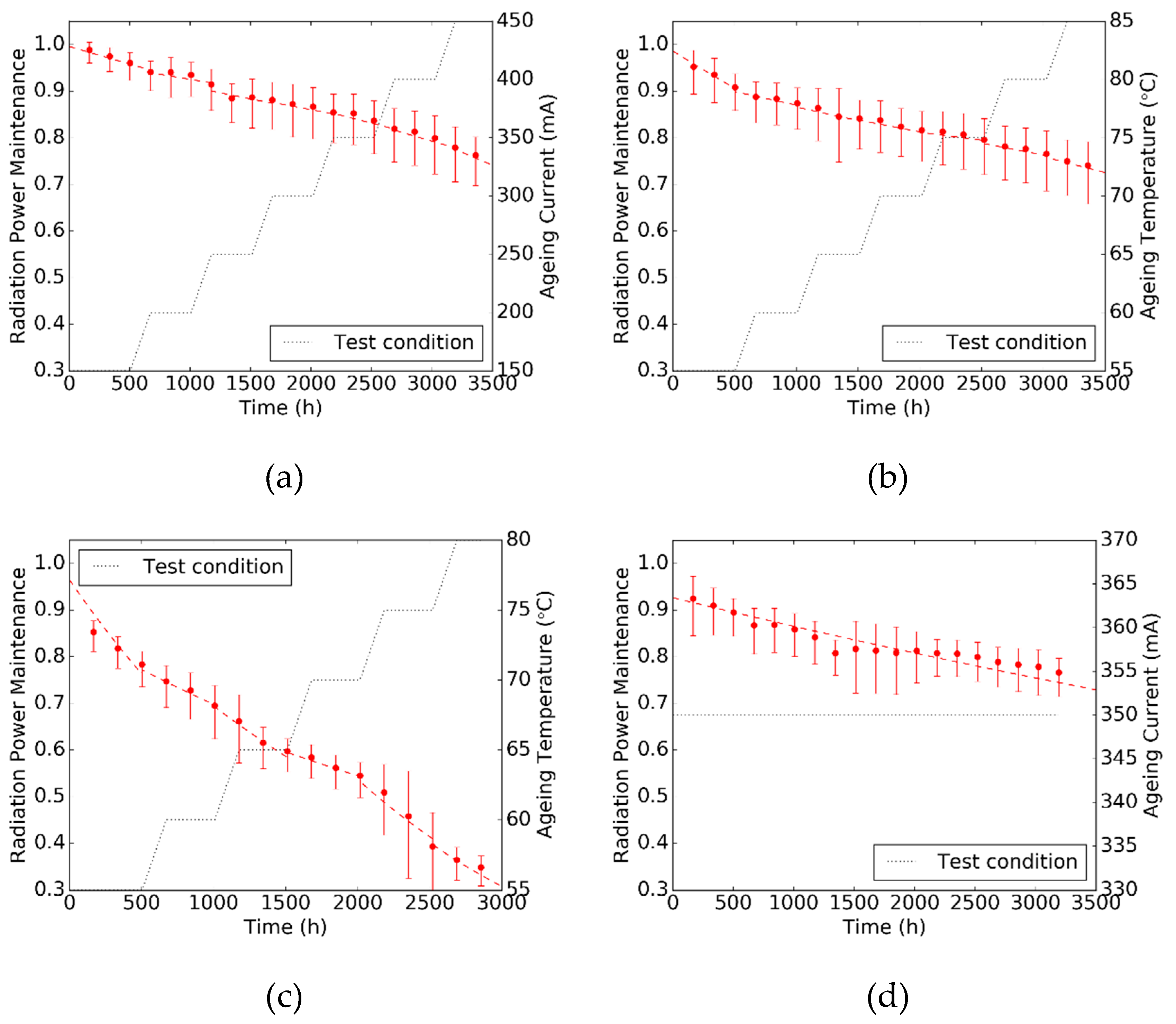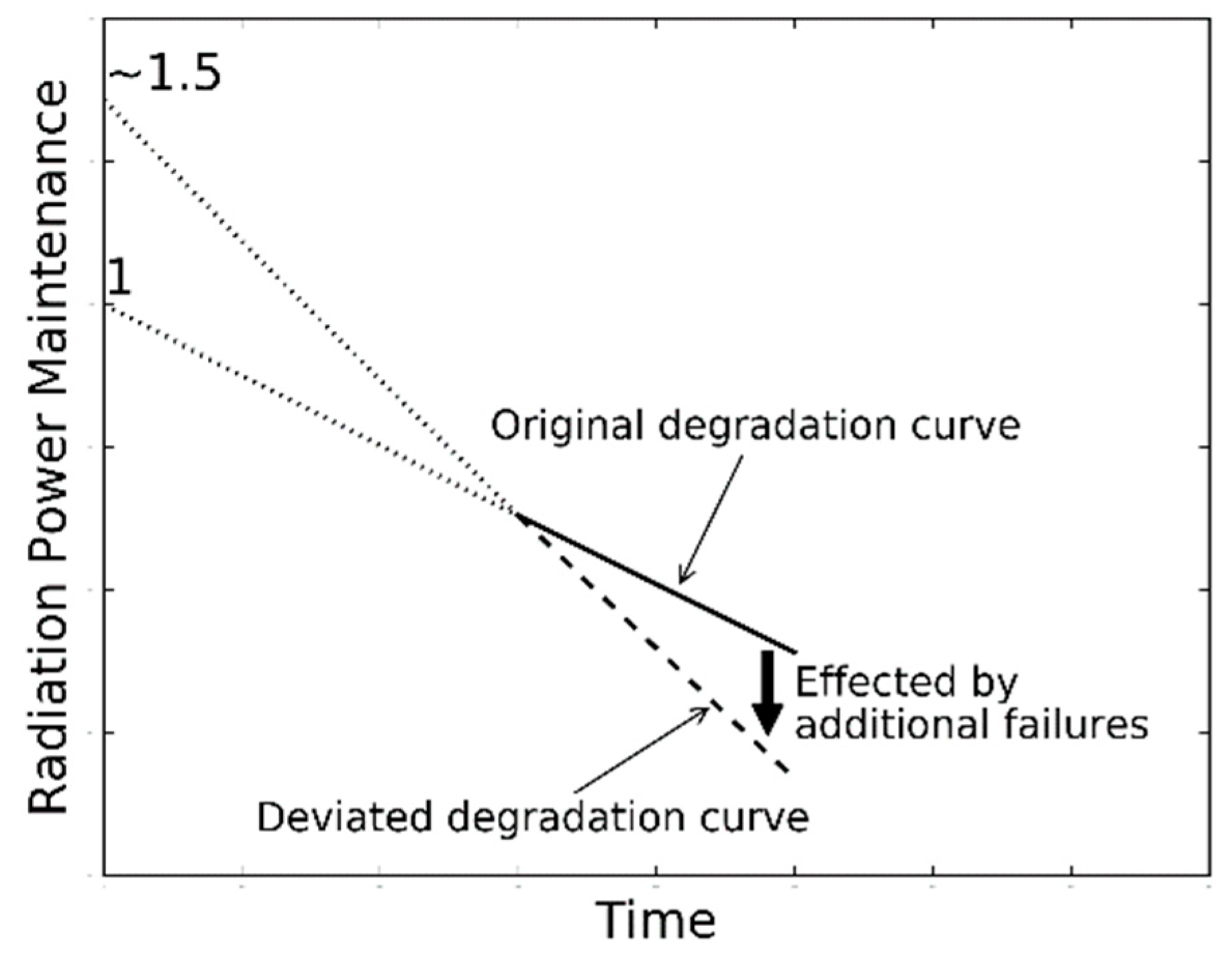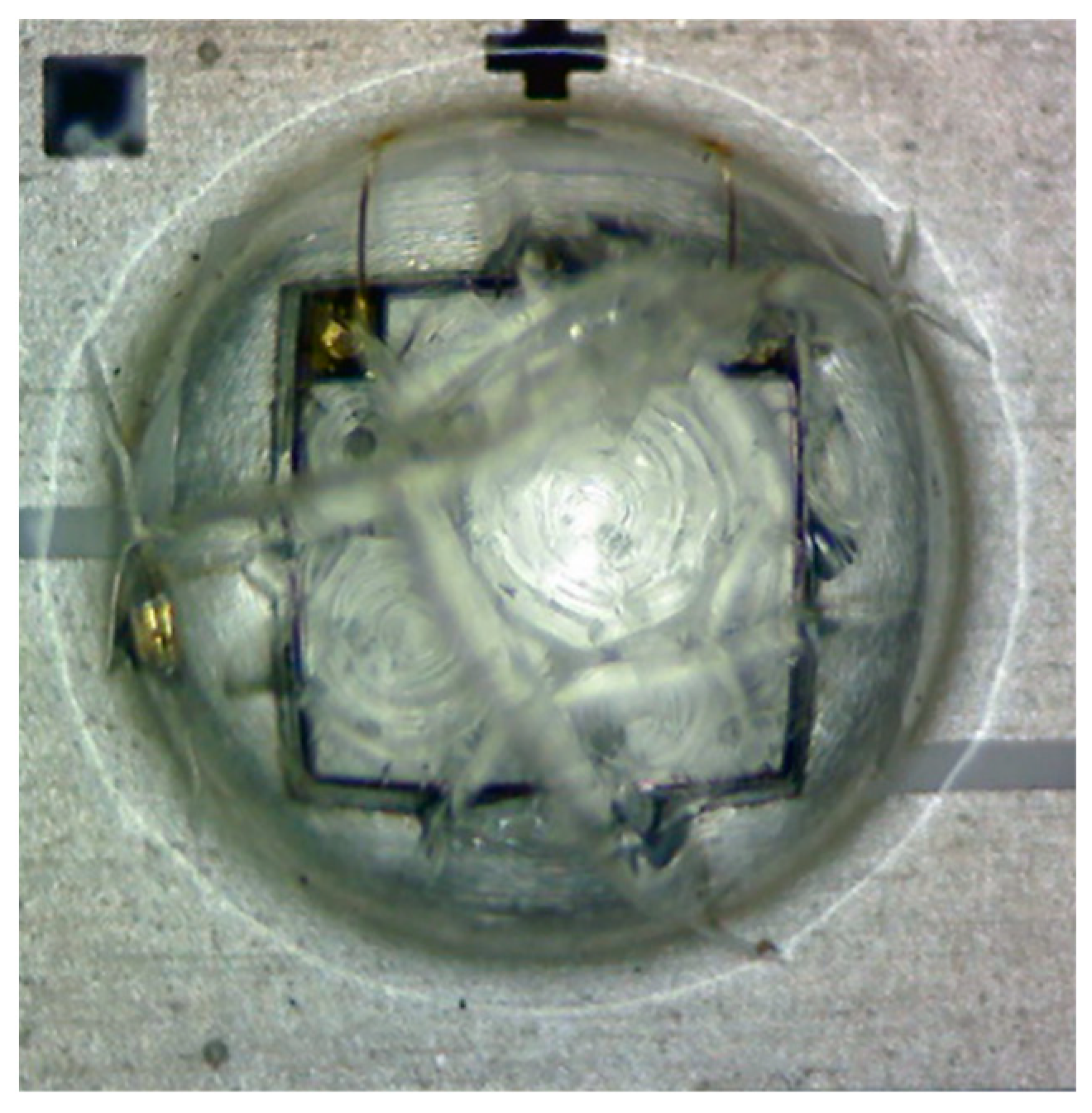Investigation of Step-Stress Accelerated Degradation Test Strategy for Ultraviolet Light Emitting Diodes
Abstract
:1. Introduction
2. Test Samples and Experiments
3. Theory and Modeling
4. Results and Discussions
5. Conclusions
Author Contributions
Funding
Conflicts of Interest
References
- Chevremont, A.C.; Farnet, A.M.; Coulomb, B.; Boudenne, J.L. Effect of coupled UV-A and UV-C LEDs on both microbiological and chemical pollution of urban wastewaters. Sci. Total. Env. 2012, 426, 304–310. [Google Scholar] [CrossRef]
- Wang, Y.; Zheng, X.; Dai, F.; Zhu, J.; Li, P.; Ma, X.; Hao, Y. Influence of constant current stress on the conduction mechanisms of reverse leakage current in UV-A light emitting diodes. Superlattices Microstruct. 2017, 112, 105–110. [Google Scholar] [CrossRef]
- Arques-Orobon, F.; Nunez, N.; Vazquez, M.; González-Posadas, V. UV LEDs reliability tests for fluoro-sensing sensor application. Microelectron. Reliab. 2014, 54, 2154–2158. [Google Scholar] [CrossRef]
- Chen, J.; Loeb, S.; Kim, J.H. LED revolution: fundamentals and prospects for UV disinfection applications. Env. Sci. Water Res. Technol. 2017, 3, 188–202. [Google Scholar] [CrossRef]
- Arques-Orobon, F.J.; Nuñez, N.; Vazquez, M.; Segura-Antunez, C.; González-Posadas, V. High-power UV-LED degradation: Continuous and cycled working condition influence. Solid State Electronics 2015, 111, 111–117. [Google Scholar] [CrossRef] [Green Version]
- Gong, Z.; Gaevski, M.; Adivarahan, V.; Sun, W.; Shatalov, M.; Khan, M.A. Optical power degradation mechanisms in AlGaN-based deep ultraviolet light emitting diodes on sapphire DUV. Appl. Phys. Lett. 2006, 88, 121106. [Google Scholar] [CrossRef]
- Meneghini, M.; Barbisan, D.; Bilenko, Y.; Shatalov, M.; Yang, J.; Gaska, R.; Meneghesso, G.; Zanoni, E. Defect-related degradation of Deep-UV-LEDs. Microelectron. Reliab. 2010, 50, 1538–1542. [Google Scholar] [CrossRef]
- Lu, K.; Zhang, W.; Sun, B. Multidimensional Data-Driven Life Prediction Method for White LEDs Based on BP-NN and Improved-Adaboost Algorithm. Ieee Access 2017, 5, 21660–21668. [Google Scholar] [CrossRef]
- Wu, Z.; Wang, Z.; Feng, Q.; Sun, B.; Qian, C.; Ren, Y.; Jiang, X. A Gamma Process-Based Prognostics Method for CCT Shift of High-Power White LEDs. Ieee Trans. Electron Devices 2018, 65, 2909–2916. [Google Scholar] [CrossRef]
- Yang, X.; Sun, B.; Wang, Z.; Qian, C.; Ren, Y.; Yang, D.; Feng, Q. An Alternative Lifetime Model for White Light Emitting Diodes under Thermal–Electrical Stresses. Materials 2018, 11, 817. [Google Scholar] [CrossRef]
- Yung, K.C.; Sun, B.; Jiang, X.; Yung, W.K.C. Prognostics-based qualification of high-power white LEDs using Lévy process approach. Mech. Syst. Signal Process. 2017, 82, 206–216. [Google Scholar] [CrossRef]
- Nelson, W.B. Accelerated Testing: Statistical Models, Test Plans, and Data Analysis; John Wiley & Sons Inc.: New York, NY, USA, 2004. [Google Scholar]
- Sun, B.; Jiang, X.; Yung, K.C.; Fan, J.; Pecht, M.G.; Yung, W.K.C. A Review of Prognostic Techniques for High-Power White LEDs. Ieee Trans. Power Electron. 2017, 32, 6338–6362. [Google Scholar] [CrossRef]
- Glaab, J.; Ploch, C.; Kelz, R.; Stölmacker, C.; Lapeyrade, M.; Ploch, N.L.; Rass, J.; Kolbe, T.; Einfeldt, S.; Mehnke, F.; et al. Degradation of (InAlGa)N-based UV-B light emitting diodes stressed by current and temperature. J. Appl. Phys. 2015, 118, 094504. [Google Scholar] [CrossRef]
- Monti, D.; Meneghini, M.; De Santi, C.; Meneghesso, G.; Zanoni, E.; Glaab, J.; Rass, J.; Einfeldt, S.; Mehnke, F.; Enslin, J.; et al. Defect-Related Degradation of AlGaN-Based UV-B LEDs. Ieee Trans. Electron Devices 2016, 64, 200–205. [Google Scholar] [CrossRef]
- Zhou, J.; Ibrahim, M.S.; Fan, J.J.; Fan, X.J.; Zhang, G.Q. Lifetime Prediction of Ultraviolet Light-emitting Diodes with Accelerated Wiener Degradation Process. In Proceedings of the 20th International Conference on Thermal, Mechanical and Multi-Physics Simulation and Experiments in Microelectronics and Microsystems (EuroSimE), Hannover, Germany, 24–27 March 2019. [Google Scholar]
- Trivellin, N.; Monti, D.; De Santi, C.; Buffolo, M.; Meneghesso, G.; Zanoni, E.; Meneghini, M. Current induced degradation study on state of the art DUV LEDs. Microelectron. Reliab. 2018, 90, 868–872. [Google Scholar] [CrossRef]
- Pinos, A.; Marcinkevičius, S.; Shur, M. High current-induced degradation of AlGaN ultraviolet light emitting diodes. J. Appl. Phys. 2011, 109, 103108. [Google Scholar] [CrossRef]
- Reed, M.L.; Wraback, M.; Lunev, A.; Bilenko, Y.; Hu, X.; Sattu, A.; Deng, J.; Shatalov, M.; Gaska, R. Device self-heating effects in deep UV LEDs studied by systematic variation in pulsed current injection. Phys. Status Solidi (C) 2008, 5, 2053–2055. [Google Scholar] [CrossRef]
- Escobar, L.A.; Meeker, W.Q. A Review of Accelerated Test Models. Stat. Sci. 2006, 21, 552–577. [Google Scholar] [CrossRef] [Green Version]
- He, Q.; Chen, W.; Pan, J.; Qian, P. Improved step stress accelerated life testing method for electronic product. Microelectron. Reliab. 2012, 52, 2773–2780. [Google Scholar]
- Cai, M.; Yang, D.; Tian, K.; Zhang, P.; Chen, X.; Liu, L.; Zhang, G. Step-stress accelerated testing of high-power LED lamps based on subsystem isolation method. Microelectron. Reliab. 2015, 55, 1784–1789. [Google Scholar] [CrossRef]
- Cai, M.; Yang, D.; Zheng, J.; Mo, Y.; Huang, J.; Xu, J.; Chen, W.; Zhang, G.; Chen, X. Thermal degradation kinetics of LED lamps in step-up-stress and step-down-stress accelerated degradation testing. Appl. Eng. 2016, 107, 918–926. [Google Scholar] [CrossRef]
- Qian, C.; Fan, J.; Fang, J.; Yu, C.; Ren, Y.; Fan, X.; Zhang, G. Photometric and Colorimetric Assessment of LED Chip Scale Packages by Using a Step-Stress Accelerated Degradation Test (SSADT) Method. Materials 2017, 10, 1181. [Google Scholar] [CrossRef] [PubMed]
- Wang, J.; Ma, X. Study on LED devices step-stress accelerated degradation test. In Proceedings of the 2013 14th International Conference on Electronic Packaging Technology, Dalian, China, 11–14 August 2013; pp. 1162–1165. [Google Scholar]
- Benavides, E.M. Reliability model for step-stress and variable-stress situations. Ieee Trans. Reliab. 2011, 60, 219–233. [Google Scholar] [CrossRef]
- Tseng, S.T.; Wen, Z.C. Step-Stress Accelerated Degradation Analysis for Highly Reliable Products. J. Qual. Technol. 2000, 32, 209–216. [Google Scholar] [CrossRef]
- Hu, C.H.; Plante, R.D.; Tang, J. Statistical equivalency and optimality of simple step-stress accelerated test plans for the exponential distribution. Nav. Res. Logist. 2013, 60, 19–30. [Google Scholar] [CrossRef]
- IES LM-80-15. Approved Method for Lumen Maintenance Testing of LED Light Source; Illuminating Engineering Society: New York, NY, USA, 2015. [Google Scholar]
- IES TM-21-11. Projecting Long Term Lumen Maintenance of LED Light Sources; Illuminating Engineering Society: New York, NY, USA, 2011. [Google Scholar]







| Test ID | T (°C) | I (mA) | α | β |
|---|---|---|---|---|
| Test A | 55 | 150 | 9.294 × 10−5 | 1.00 |
| 55 | 200 | 5.546 × 10−5 | 0.98 | |
| 55 | 250 | 7.473 × 10−5 | 0.99 | |
| 55 | 300 | 5.791 × 10−5 | 0.96 | |
| 55 | 350 | 8.670 × 10−5 | 1.03 | |
| 55 | 400 | 1.009 × 10−4 | 1.07 | |
| 55 | 450 | 1.189 × 10−4 | 1.13 | |
| Test B | 55 | 350 | 1.683 × 10−4 | 0.99 |
| 60 | 350 | 6.555 × 10−5 | 0.93 | |
| 65 | 350 | 6.790 × 10−5 | 0.93 | |
| 70 | 350 | 6.228 × 10−5 | 0.92 | |
| 75 | 350 | 4.202 × 10−5 | 0.88 | |
| 80 | 350 | 6.597 × 10−5 | 0.93 | |
| 85 | 350 | 9.194 × 10−5 | 1.00 | |
| Test C | 55 | 700 | 4.683 × 10−4 | 0.97 |
| 60 | 700 | 2.033 × 10−4 | 0.86 | |
| 65 | 700 | 3.380 × 10−4 | 0.97 | |
| 70 | 700 | 1.804 × 10−4 | 0.78 | |
| 75 | 700 | 5.204 × 10−4 | 1.52 | |
| 80 | 700 | 5.278 × 10−4 | 1.50 | |
| Test D | 55 | 350 | 6.857 × 10−5 | 0.93 |
| Test ID | Relevant Model | a | b |
|---|---|---|---|
| Test A | Equation (5) | −14.27 | 0.85 |
| Test B | Equation (4) | −6.17 | −1172.23 |
| Test C | Equation (4) | 8.24 | −5532.46 |
| Test ID | α | Error |
|---|---|---|
| Test A | 9.223 × 10−5 | 34.4% |
| Test B | 5.886 × 10−5 | −14.1% |
| Test C | 1.787 × 10−4 | 160.9% |
© 2019 by the authors. Licensee MDPI, Basel, Switzerland. This article is an open access article distributed under the terms and conditions of the Creative Commons Attribution (CC BY) license (http://creativecommons.org/licenses/by/4.0/).
Share and Cite
Liang, B.; Wang, Z.; Qian, C.; Ren, Y.; Sun, B.; Yang, D.; Jing, Z.; Fan, J. Investigation of Step-Stress Accelerated Degradation Test Strategy for Ultraviolet Light Emitting Diodes. Materials 2019, 12, 3119. https://doi.org/10.3390/ma12193119
Liang B, Wang Z, Qian C, Ren Y, Sun B, Yang D, Jing Z, Fan J. Investigation of Step-Stress Accelerated Degradation Test Strategy for Ultraviolet Light Emitting Diodes. Materials. 2019; 12(19):3119. https://doi.org/10.3390/ma12193119
Chicago/Turabian StyleLiang, Banglong, Zili Wang, Cheng Qian, Yi Ren, Bo Sun, Dezhen Yang, Zhou Jing, and Jiajie Fan. 2019. "Investigation of Step-Stress Accelerated Degradation Test Strategy for Ultraviolet Light Emitting Diodes" Materials 12, no. 19: 3119. https://doi.org/10.3390/ma12193119





